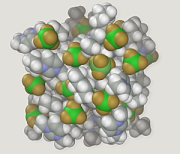
Photo from wikipedia
Background: Possible bioisosteres can be developed by replacing the 1-indanone ring (one of three pharmacophore groups) of donepezil with an indoline ring. As H2S donors, thioamide, thiocarbamate and thiourea groups… Click to show full abstract
Background: Possible bioisosteres can be developed by replacing the 1-indanone ring (one of three pharmacophore groups) of donepezil with an indoline ring. As H2S donors, thioamide, thiocarbamate and thiourea groups are also critically important. Materials & methods: The 1-benzyl-2-indolinones 6a-n were designed using molecular modeling and synthesized, and their acetylcholinesterase and butyrylcholinesterase inhibitory effects were then investigated. Results: The compounds 6h (inhibition constant [Ki] = 0.22 μM; selectivity index [SI] = 26.22), 6i (Ki = 0.24 μM; SI = 25.83), 6k (Ki = 0.22 μM; SI = 28.31) and 6n (Ki = 0.21 μM; SI = 27.14) were approximately twofold more effective against and >12-fold more selective for acetylcholinesterase compared with donepezil (Ki = 0.41 μM; SI = 2.12). Analysis of molecular dynamics simulations with compounds 6k and 6n indicated that the preferred binding might be at allosteric binding pocket 4 of the enzyme. Conclusion: Benzyl substitution at the 1-position of the indole ring significantly increased potency and selectivity.
Journal Title: Future medicinal chemistry
Year Published: 2022
Link to full text (if available)
Share on Social Media: Sign Up to like & get
recommendations!